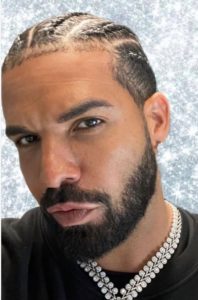 In the African-American community, many live by the mantra, “hair is your wealth”. Many frequent the hair salon religiously, every 2-weeks, and are always on top of the latest hair in trend.
In the African-American community, many live by the mantra, “hair is your wealth”. Many frequent the hair salon religiously, every 2-weeks, and are always on top of the latest hair in trend.
However, it doesn't matter if you're a Black woman or man, we like to wear our hair pulled back tight, crisp, without stray hairs. Just take a look at Drake's latest braid hairstyle! But because we like to wear it like that, braids (or weaves) may be increasing our risk of hair loss, according to a new research study.
So before you get braids this season, here are three quick tips:
1. Don’t Wear Braids For Too Long
First and foremost, don't think your new braid hairstyle is going to last you for 4 months and you don't have to do anything but wake up and go. WRONG! Some men and women have been able to effectively wear braids for months with serious care. Experts recommend a maximum of only 2 months. New growth can cause the hair to be pulled on from heavy braids or constant tugging from them. Sleep patterns and daily movement can weaken or damage the new growth from consistent stretching.
2. Wrap Your Braids at Night
Yes, your braids are tight and look great. But they are also still hair. Your extensions will only fray more when the friction of your bedding hits them, and you’re in for some pretty puffy roots once your new growth comes in. Something that can significantly reduce both of these things is tying your hair down at night. Here are a few steps to keep your hair looking its best at night, click here.

And last, but certainly not least...
3. Keep Your Scalp Moist
Moisture, moisture, moisture! Let's say it again for the people in the back; moisture! Break out a Spray Bottle and spray your thirsty roots. It only takes a couple of minutes to moisturize your hair. Just like every other living thing on this earth, your hair needs moisture to survive. The number #1 moisturizer for your thirsty roots is water…PERIOD! Something else that you can do is apply some mousse to your braids, pull them back in a low ponytail and tie them down with a silk or satin scarf. In about an hour, they will be looking fresh and smooth again.
A team of researchers from Johns Hopkins School of Medicine in Baltimore reviewed 19 studies and found a "strong association" between scalp-pulling hairstyles and traction alopecia, which is gradual hair loss from damage to the hair follicle from tension at the hair root.
Traction alopecia is the most common type of hair loss among black American women, affecting about one out of three, the researchers said.
The study did not prove a definitive cause-and-effect connection. But, styles linked to this type of hair loss include braids, tight ponytails, dreadlocks, weaves, and extensions, especially if the hair has been chemically straightened, the review said.
So, what does it look like?
In the first stages, traction alopecia may appear as little bumps on your scalp that look like pimples. However, as the condition progresses, the main symptom is missing and broken hairs. The hairs on the front and sides of your scalp are most often affected. However, many may also notice hair loss on other areas of their scalp, depending on the hairstyle.
In addition to hair loss, traction alopecia can cause these symptoms:
-
- redness of the scalp
- bumps
- soreness or stinging of your scalp
- itching
- scaling
- folliculitis (inflammation of the hair follicles)
- pus-filled blisters on your scalp
According to Cicatricial Alopecia Research Foundation (CARF), ultimately the hair follicles can become so damaged and scarred that they can’t produce new hair. The symptoms of traction alopecia are different from those of other forms of alopecia. In other types, the hair loss occurs in patches all over the scalp. In traction alopecia, usually just the hair that’s been pulled is affected.
"Hair is a cornerstone of self-esteem and identity for many people but ironically, some hairstyles meant to improve our self-confidence actually lead to hair and scalp damage," Dr. Crystal Aguh, an assistant professor of dermatology at Hopkins, said in a university news release.
The findings show the need for dermatologists to learn more about these potentially damaging forms of hairstyles and to advise patients about the risks and alternatives, the researchers suggested.
Traction alopecia is preventable and early intervention can stop or reverse it, the researchers said. Alternating hairstyles, and avoiding those that constantly pull at the hair roots may help, they noted.
"We have to do better as care providers to offer our patients proper guidance to keep them healthy from head to toe," Aguh said.
How Can You Prevent It?
To prevent traction alopecia, wear your hair down. If you have to pull it up into a ponytail or bun, keep it loose and low on your head. Switch up your hairstyle every couple of weeks, you can alternate between braids and wearing your hair down to relax the hair shaft. When you pull your hair up into a ponytail, try not to use rubber or elastic bands to hold it in place. They often pull out your hair when removing them.
Avoid chemically processing your hair and using hair relaxers. If you use weaves or braid your hair, once it’s time to braid it is more prone to break because of the thinness. The chemicals can damage your hair, making it more likely to break when braiding. If you have weaves or extensions, wear them for only a short period of time and take a break between your next install.
When braiding your hair, make sure the braids are thick. Thinner braids pull more tightly. Don’t sleep in rollers. Wrap your hair instead. If you wear wigs often, choose one with a satin wig cap. Satin caps don’t pull as hard on your scalp and prevent your hair from snagging on the material.
SOURCE: Johns Hopkins University, news release, April 27, 2016








